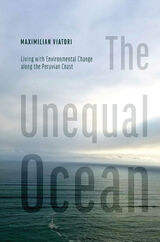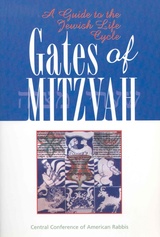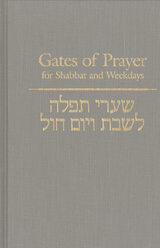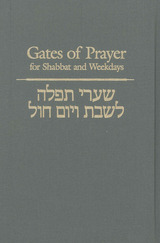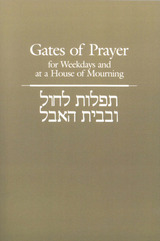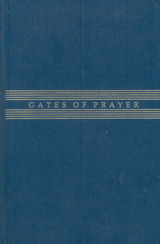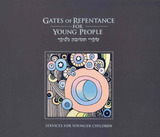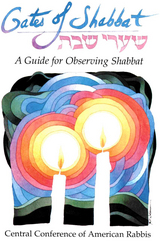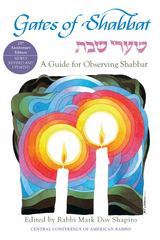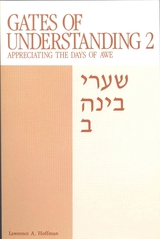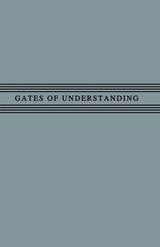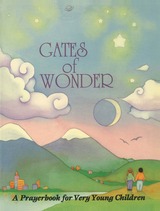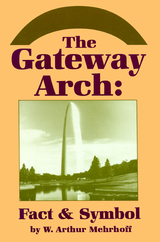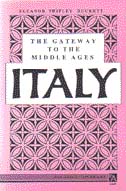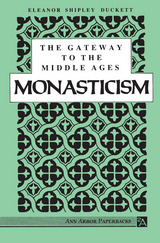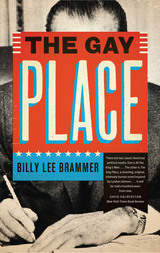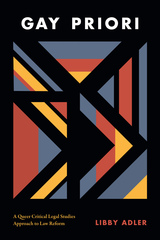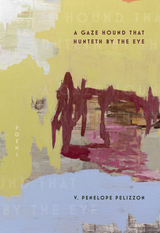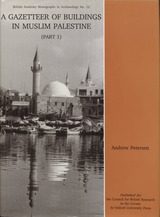Gates of Mitzvah
Simeon J. Maslin
Central Conference of American Rabbis, 1972 This comprehensive guide to Jewish observance throughout the life cycle is the best introduction to Reform Jewish practice available. It includes sections on birth, childhood and education, marriage and the Jewish home, and death and mourning, as well as essays on sexuality, kashrut, divorce and the single parent family, Jewish ethical wills, tzedakah and other topics. Shaarei Mitzvah also features extensive notes and references for further study.
Gates of Prayer for Shabbat and Weekdays - English-opening, Gender-Inclusive
Chaim Stern
Central Conference of American Rabbis, 1994 Gates of Prayer for Shabbat and Weekdays contains services for Shabbat and weekdays, evening and morning, within the covers of a single, elegantly designed, hardbound volume. The selection of three complete services for Erev Shabbat enables congregations to use this book regularly for most worship purposes.
Gates of Prayer for Shabbat and Weekdays-Hebrew-opening, Gender-Inclusive
Chaim Stern
Central Conference of American Rabbis, 1994 Gates of Prayer for Shabbat and Weekdays contains services for Shabbat and weekdays, evening and morning, within the covers of a single, elegantly designed, hardbound volume. The selection of three complete services for Erev Shabbat enables congregations to use this book regularly for most worship purposes.
Gates of Prayer for Weekdays and at a House of Mourning
Chaim Stern
Central Conference of American Rabbis, 1992 Includes services for the funeral home and the house of the bereaved, afternoon and evening services, special "At a House of Mourning" service, additional readings, meditations, and Kaddish.
Gates of Prayer for Young People
Roy A. Walter
Central Conference of American Rabbis, 1997 Gates of Prayer for Young People fills the need for daily and Shabbat services in congregational worship and the religious school setting. Building on its forerunners Gates of Wonder and Gates of Awe, this innovative volume includes evening and morning services for weekdays and Shabbat. Enhanced by full-color art throughout, this text is contemporary, gender-inclusive and designed for young people between five and twelve years of age.
Gates of Prayer, Large Print, Hebrew Opening
Chaim Stern
Central Conference of American Rabbis Deeply rooted in Jewish tradition, while expressing that tradition within the context of Reform Judaism, this prayerbook contains a variety of services for weekdays, Shabbat and festivals, Israeli Independence Day, Holocaust Remembrance Day and Tisha B'Av. It also includes special readings, meditations and 40 pages of songs complete with transliterations.
Gates of Repentance - English Open
Chaim Stern
Central Conference of American Rabbis Gates of Repentance, containing services, readings, meditations and songs for Rosh HaShanah and Yom Kippur, features contemporary, gender-inclusive language throughout. Like its companion, Gates of Prayer, this volume combines the old with the new and supplies each congregation latitude in establishing its own patterns of worship.
Gates of Repentance - Hebrew Open
Chaim Stern
Central Conference of American Rabbis Gates of Repentance, containing services, readings, meditations and songs for Rosh HaShanah and Yom Kippur, features contemporary, gender-inclusive language throughout. Like its companion, Gates of Prayer, this volume combines the old with the new and supplies each congregation latitude in establishing its own patterns of worship.
Gates of Repentance - LP - Hebrew
Chaim Stern
Central Conference of American Rabbis, 1997 Gates of Repentance, containing services, readings, meditations and songs for Rosh HasShanah and Yom Kippur, features contemporary, gender-inclusive language throughout. Like its companion, Gates of Prayer, this volume combines the old with the new and supplies each congregation latitude in establishing its own patterns of worship.
Gates of Repentance for Young People
Rabbi Judith Abrams
Central Conference of American Rabbis, 2002 Gates of Repentance for Young People is the Machzor designed for children's High Holy Day services; it completes the series begun with Gates of Wonder, Gates of Awe, and Gates of Prayer for Young People. Each service emphasizes the significant themes of the High Holy Days in engaging ways. The volume includes services for Rosh HaShanah and Yom Kippur for both early and late primary grades in contemporary, gender-inclusive language. It also contains new translations of the High Holy Day readings from the Torah and Haftarot as well as illustrations by award-winning artist Neil Waldman.
Gates of Shabbat
Neil Waldman
Central Conference of American Rabbis, 1991 Gates of Shabbat is a comprehesive how-to guide containing detailed yet concise information about the Jewish Sabbath at home and in the synagogue. A full appreciation of Jewish custom, ritual and tradition enriches the book, while detailed discussion of the many choices facing contemporary Jews gives it broad appeal. Designed for ease of use, Gates of Shabbat assumes no prior knowledge on the part of its readers, and is an excellent reference for Jews and non-Jews alike.
Gates of Shabbat - Shaarei Shabbat: A Guide for Observing Shabbat, Revised Edition
Rabbi Mark Dov Shapiro
Central Conference of American Rabbis, 2016 This 25th anniversary edition is a completely revised and updated version of the classic how-to guide about Shabbat observance and practices.
This book is about Shabbat--the Jewish treasure that comes around every seven days. In the midst of our freedom, Shabbat offers roots and inspiration along with joy and hope. In the midst of a world of endless choices and paths, Judaism provides the rich resources developed for living a life of meaning over centuries of practice. In particular, Judaism offers Shabbat as a way to deepen, renew, and refresh our lives.
Through additional essays, poetry, and personal insights, as well as many new inspiring and creative ideas, this updated edition of Gates of Shabbat offers a roadmap to discovering and exploring what Shabbat can mean to you.
 Gates Of The Elect Kingdom
John Wood
University of Iowa Press, 1997 The four parts of this highly accomplished collection showcase the different facets and wide breadth of John Wood's poetic talent. Displayed here are his ability to sustain a sequence, his adeptness with lyricism and the short form, and his sensuous feeling for this life and the life of the past. In regard to the latter, Wood begins the book with his poetic account of the amazing life and adventures of the vigorous American utopianist Wilhelm Johannes Hoade. Wood's account reads like a novel as he weaves a fictional narrative out of lyric poetry, a narrative that is finally convincing and true in spite of its obvious impossibility. The second section, “Homage to Dafydd ap Gwilym,” is a free but artistically faithful translation after some of the medieval Welsh poet's major poems, arranged in a way to suggest in a natural/supernatural mode his remarkable character and biography. The third part is a group of finely tuned, mostly lyric poems dealing with family, friends, and intellectual concerns; the fourth is a group of contemporary and historical “revelations,” quite striking in scope and variety. All combine to form a dazzling whole.
Gates of the Seasons
Peter S. Knobel
Central Conference of American Rabbis, 1983 A survey of the sacred days of the Jewish yearly cycle providing detailed guidance on observing the Sabbath and the Jewish holidays, including Yom HaShoah (Holocaust Day) and Yom Ha-Atzma-ut (Israeli Independence Day). Gates of the Seasons provides historical background, essays, extensive notes, a bibliography, glossary and an index.
Gates of Understanding: Shaarei Bina - Vol. II: Appreciating the Days of Awe
Rabbi Lawrence A. Hoffman
Central Conference of American Rabbis, 1977 A religious commentary to help High Holy Days worshipers unlock the message behind the liturgy. Covers the history and tradition of the prayers, music in the service, synagogue poetry, the role of God, sin and repentance and much more. Also includes comprehensive notes to Gates of Repentance and a thorough index.
Gates of Understanding Volume 1 - PDF Electronic Version: A Companion Volume to Gates of Prayer
Chaim Stern
Central Conference of American Rabbis, 1977 This companion volume to Gates of Prayer includes essays on worship, liturgy, holiness, theology, music, and more, written by leading thinkers of their day. Also included are notes on Gates of Prayer written by Chaim Stern and A. Stanley Dreyfus. An invaluable resource for anyone interested in the history and development of liturgy and Reform Jewish practice.
Gates of Wonder: A Prayerbook for Very Young Children
Rabbi Howard Bogot
Central Conference of American Rabbis, 1989 This is the first official prayerbook for young children ever produced by the Reform Movement. Intended for pre-school children through six years of age, Gates of Wonder is beautifully illustrated by award-winning artist Neil Waldman. As young children enter the Gates of Wonder they will experience a world of beauty, a world of mystery and the enduring world of Jewish prayer.
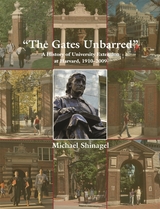 The Gates Unbarred: A History of University Extension at Harvard, 1910 - 2009
Michael Shinagel
Harvard University Press The Gates Unbarred traces the evolution of University Extension at Harvard from the Lyceum movement in Boston to its creation by the newly appointed president A. Lawrence Lowell in 1910. For a century University Extension has provided community access to Harvard, including the opportunity for women and men to earn a degree.
In its storied history, University Extension played a pioneering role in American continuing higher education: initiating educational radio courses with Harvard professors in the late 1940s, followed by collegiate television courses for credit in the 1950s, and more recently Harvard College courses available online. In the 1960s a two-year curriculum was prepared for the U.S. nuclear navy (“Polaris University”), and in the early 1970s Extension responded to community needs by reaching out to Cambridge and Roxbury with special applied programs.
This history is not only about special programs but also about remarkable people, from the distinguished members of the Harvard faculty who taught evenings in Harvard Yard to the singular students who earned degrees, ranging from the youngest ALB at age eighteen, to the oldest ALB and ALM recipients, both aged eighty-nine—and both records at Harvard University.
The Gateway Arch: Fact & Symbol
W. Arthur Mehrhoff
University of Wisconsin Press, 1992 Like the nation that it symbolizes, the bold arch of the Jefferson National Expansion Memorial poses enormous contradictions. It is a simple, classical architectural form constructed with the most sophisticated modern engineering. It is a national historic site created by demolishing nearly forty blocks of historic riverfront buildings. It is the perfect place to examine critical, historic tensions in American culture.
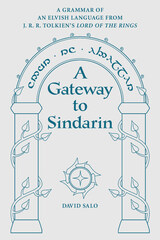 A Gateway to Sindarin: A Grammar of an Elvish Language from JRR Tolkien's Lord of the Rings
David Salo
University of Utah Press, 2004 From the 1910s to the 1970s, author and linguist J. R. R. Tolkien worked at creating plausibly realistic languages to be used by the creatures and characters in his novels. Like his other languages, Sindarin was a new invention, not based on any existing or artificial language. By the time of his death, he had established fairly complete descriptions of two languages, the "elvish" tongues Quenya and Sindarin. He was able to compose poetic and prose texts in both, and he also constructed a lengthy sequence of changes for both from an ancestral "proto-language," comparable to the development of historical languages and capable of analysis with the techniques of historical linguistics.
In A Gateway to Sindarin, David Salo has created a volume that is a serious look at an entertaining topic. Salo covers the grammar, morphology, and history of the language. Supplemental material includes a vocabulary, Sindarin names, a glossary of terms, and an annotated list of works relevant to Sindarin. What emerges is an homage to Tolkien's scholarly philological efforts.
The Gateway to the Middle Ages: Italy
Eleanor Shipley Duckett
University of Michigan Press, 1988 Portrays the struggle to defend Italian lands against the Eastern Goths and barbarians from the North.
The Gateway to the Middle Ages: Monasticism
Eleanor Shipley Duckett
University of Michigan Press, 1988 In an era when the sounds of monasticism's interior life speak to a new generation, Eleanor Shipley Duckett offers an illuminated description of its development under such figures as Columban, "the saint afire with Irish enthusiam"; St. Benedict, greatest of the monks, who established a pattern of the religious life still vibrant to this day; and St. Gregory, Benedict's pupil and greatest of the popes, who more than any other prepared the See of Rome for its triumphant emergence in the Middle Ages.
"Professor Duckett writes a history of this period that is as full of intellectual excitement as those centuries were of military excitement." -- Christian Century
"New light on the troubled origins of the medieval spirit." --New Republic
Eleanor Shipley Duckett was Professor Emerita of Latin Languages and Literature, Smith College.
 The Gateway to the Pacific: Japanese Americans and the Remaking of San Francisco
Meredith Oda
University of Chicago Press, 2018 In the decades following World War II, municipal leaders and ordinary citizens embraced San Francisco’s identity as the “Gateway to the Pacific,” using it to reimagine and rebuild the city. The city became a cosmopolitan center on account of its newfound celebration of its Japanese and other Asian American residents, its economy linked with Asia, and its favorable location for transpacific partnerships. The most conspicuous testament to San Francisco’s postwar transpacific connections is the Japanese Cultural and Trade Center in the city’s redeveloped Japanese-American enclave.
Focusing on the development of the Center, Meredith Oda shows how this multilayered story was embedded within a larger story of the changing institutions and ideas that were shaping the city. During these formative decades, Oda argues, San Francisco’s relations with and ideas about Japan were being forged within the intimate, local sites of civic and community life. This shift took many forms, including changes in city leadership, new municipal institutions, and especially transformations in the built environment. Newly friendly relations between Japan and the United States also meant that Japanese Americans found fresh, if highly constrained, job and community prospects just as the city’s African Americans struggled against rising barriers. San Francisco’s story is an inherently local one, but it also a broader story of a city collectively, if not cooperatively, reimagining its place in a global economy.
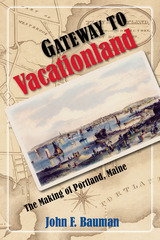 Gateway to Vacationland: The Making of Portland, Maine
John F. Bauman
University of Massachusetts Press, 2012 Situated on a peninsula jutting into picturesque Casco Bay, Portland has long been admired for its geographical setting—the "beautiful city by the sea," as native son Henry Wadsworth Longfellow called it. At the same time, Portland's deep, ice-free port has made it an ideal site for the development of coastal commerce and industry. Much of the city's history, John F. Bauman shows, has been defined by the effort to reconcile the competing interests generated by these attributes—to balance the imperatives of economic growth with a desire to preserve Portland's natural beauty.
Caught in the crossfire of British and French imperial ambitions throughout the colonial era, Portland emerged as a prosperous shipbuilding center and locus of trade in the decades following the American Revolution. During the nineteenth century it became a busy railroad hub and winter port for Canadian grain until a devastating fire in 1866 reduced much of the city to ruins. Civic leaders responded by reinventing Portland as a tourist destination, building new hotels, parks, and promenades, and proclaiming it the "Gateway to Vacationland."
After losing its grain trade in the 1920s and suffering through the Great Depression, Portland withered in the years following World War II as it wrestled with the problems of deindustrialization, suburbanization, and an aging downtown. Efforts at urban renewal met with limited success until the 1980s, when a concerted plan of historic preservation and the restoration of the Old Port not only revived the tourist trade but eventually established Portland as one of America's "most livable cities."
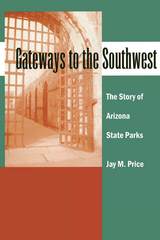 Gateways to the Southwest: The Story of Arizona State Parks
Jay M. Price
University of Arizona Press, 2004 Arizona is home to some of the region's most stunning national parks and monuments and has had a long tradition of strong federal agencies—along with effective local governments—developing and managing parklands. Before World War II, protecting sites from development seemed counterproductive to a state government dominated by extractive industries. By the late 1950s this state that prided itself on being a tourist destination found its lack of state parks to be an embarrassment. Gateways to the Southwest is a history of the creation of state parks in Arizona, examining the ways in which different types of parks were created in the face of changing social values. Jay Price tells how Arizona's parks emerged from the recreation and tourism boom of the 1950s and 1960s, were shaped by the environmental movement of the 1970s and 1980s, and have been affected by the financial challenges that arose in the 1990s. He also explains how changing political realities led to different methods of creating parks like Catalina, Homol'ovi Ruins, and Kartchner Caverns. In addition, places that did not become state parks have as much to tell us as those that did. By the time the need for state parks was recognized in Arizona, most choice sites had already been developed, and Price reveals how acquiring land often proved difficult and expensive. State parks were of necessity developed in cooperation with the federal government, other state agencies, community leaders, and private organizations. As a result, parks born from land exchanges, partnerships, conservation easements, and other cooperative ventures are more complicated entities than the "state park" designation might suggest. Price's study shows that the key issue for parks has not been who owns a place but who manages it, and today Arizona's state parks are a network of lake-based recreation, historic sites, and environmental education areas reflecting issues just as complex as those of the region's better-known national parks. Gateways to the Southwest is a case study of resource stewardship in the Intermountain West that offers new insights into environmental history as it illustrates the challenges and opportunities facing public lands all over America.
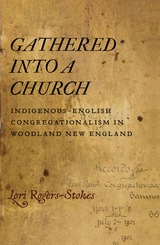 Gathered into a Church: Indigenous-English Congregationalism in Woodland New England
Lori Rogers-Stokes
University of Massachusetts Press, 2025 Uncovering how and where Indigenous and settler communities found common ground using newly public church records
Puritans in the American colonies created Congregationalism, a Protestant denomination where power rested in each congregation rather than a larger central body. As has often been told, the official Puritan mission included outreach to Indigenous people. This may appear as nothing more than forced conversion under colonization, but church records from Massachusetts—digitized and made public for the first time—reveal the authenticity of this Indigenous religious experience, as evidenced by commonalities between the Congregational way and some aspects of local Native American cultures. The records also show how the decentralized churches stood in contrast to a growing civil government in the colonies.
Lori Rogers-Stokes focuses on the Massachusetts Bay Colony during the decades around the turn of the eighteenth century, a period bookended by King Philip’s War and the First Great Awakening. She uses as her primary source the many records kept by individual Congregational churches of the time. These records, accumulated over generations, have been missing from the historical record, allowing overly simplistic accounts of this religious community to circulate. With church records now available, Rogers-Stokes reveals a more realistic picture of diverse congregations and contrasts their internal workings—which show inherent flexibility and a focus on a shared creation of community—with a developing civil government focused on consolidating power around white landowners. The result is a story that can expand how scholars write about this period, this region, and these communities, both settler and Indigenous.
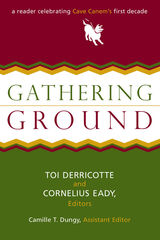 Gathering Ground: A Reader Celebrating Cave Canem's First Decade
Toi Derricotte and Cornelius Eady, Editors
University of Michigan Press, 2006 Cave Canem has for the past ten years dedicated itself to the discovery and cultivation of new voices in African American poetry. Founded in 1996 by prizewinning poets Toi Derricotte and Cornelius Eady, Cave Canem began as a weeklong summer workshop/retreat and has now expanded to include regional workshops, poetry readings, a series of public conversations between major poets and emerging younger poets, and an annual first-book prize.
To mark the first decade of this pathbreaking project, Gathering Ground presents more than one hundred poems by Cave Canem participants and faculty. It embraces an impressive and eclectic gathering of forms, including sonnets, a bop (a new form created by a Cave Canem faculty member), blues, sestinas, prose poems, centos, free verse, and more. The roster of distinguished contributors includes Lucille Clifton, Yusef Komunyakaa, Marilyn Nelson, Sonya Sanchez, Al Young, and many others.
For newcomers and aficionados alike, Gathering Ground assembles in one place the most innovative voices in contemporary African American poetry and boldly attests to the important position it holds in verse-making today.
Toi Derricotte is author of the memoir The Black Notebooks and of four books of poetry: Tender, Captivity, Natural Birth, and The Empress of the Death House. She is Professor of English at the University of Pittsburgh. Cornelius Eady is the author of Brutal Imagination, Autobiography of a Jukebox, You Don't Miss Your Water, The Gathering of My Name, and Victims of the Latest Dance Craze. He is Associate Professor of English at the University of Notre Dame.
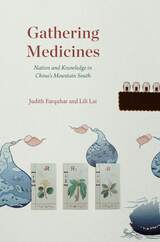 Gathering Medicines: Nation and Knowledge in China’s Mountain South
Judith Farquhar and Lili Lai
University of Chicago Press, 2021 In the early 2000s, the central government of China encouraged all of the nation’s registered minorities to “salvage, sort, synthesize, and elevate” folk medical knowledges in an effort to create local health care systems comparable to the nationally supported institutions of traditional Chinese medicine. Gathering Medicines bears witness to this remarkable moment of knowledge development while sympathetically introducing the myriad therapeutic traditions of southern China.
Over a period of six years, Judith Farquhar and Lili Lai worked with seven minority nationality groups in China’s southern mountains, observing how medicines were gathered and local healing systems codified. Gathering Medicines shares their intimate view of how people understand ethnicity, locality, the body, and nature. This ethnography of knowledge diversities in multiethnic China is a testament to the rural wisdom of mountain healers, one that theorizes, from the ground up, the dynamic encounters between formal statist knowledge and the popular authority of the wild.
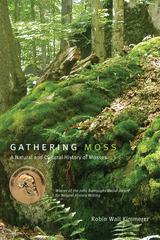 Gathering Moss: A Natural and Cultural History of Mosses
Robin Wall Kimmerer
Oregon State University Press, 2003 Winner of the 2005 John Burroughs Medal Award for Natural History Writing Living at the limits of our ordinary perception, mosses are a common but largely unnoticed element of the natural world. Gathering Moss is a beautifully written mix of science and personal reflection that invites readers to explore and learn from the elegantly simple lives of mosses. In this series of linked personal essays, Robin Wall Kimmerer leads general readers and scientists alike to an understanding of how mosses live and how their lives are intertwined with the lives of countless other beings. Kimmerer explains the biology of mosses clearly and artfully, while at the same time reflecting on what these fascinating organisms have to teach us. Drawing on her diverse experiences as a scientist, mother, teacher, and writer of Native American heritage, Kimmerer explains the stories of mosses in scientific terms as well as in the framework of indigenous ways of knowing. In her book, the natural history and cultural relationships of mosses become a powerful metaphor for ways of living in the world.
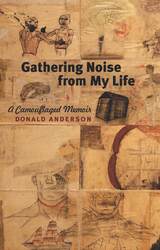 Gathering Noise from My Life: A Camouflaged Memoir
Donald Anderson
University of Iowa Press, 2012 The noise gathered from a lifetime of engaging with war, race, religion, memory, illness, and family echoes through the vignettes, quotations, graffiti, and poetry that Donald Anderson musters here, fragments of the humor and horror of life, the absurdities that mock reason and the despair that yields laughter. Gathering Noise from My Life offers sonic shards of a tune at once jaunty and pessimistic, hopeful and hopeless, and a model for how we can make sense of the scraps of our lives. “We are where we’ve been and what we’ve read,” the author says, and gives us his youth in Montana, the family tradition of boxing, careers in writing and fighting, the words of Mike Tyson, Frederick the Great, Fran Lebowitz, and Shakespeare. In his camouflaged memoir, the award-winning short-story writer cobbles together the sources of the vision of life he has accrued as a consequence of his six decades of living and reading.
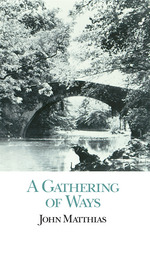 A Gathering of Ways
John Matthias
Ohio University Press, 1991 A Gathering of Ways is John Matthias’ first collection of poems since the publication of his warmly received Northern Summer collection in 1985. The book consists of three long poems dealing with the geography, geology, prehistory, and history of two places closely identified with Matthias’ work, the East Anglian region of Britain and the American Midwest, and a third place that provides the book with a new and deeply resonant setting: those parts of southern France and northern Spain through which run the famous pilgrimage routes to Santiago de Compostela. “An East Anglian Diptych” explores those parts of Cambridgeshire, Suffolk, and Norfolk linked by three rivers and by those ancient paths and tracks known as ley lines which connect locality and locality and time with time. “Facts From an Apocryphal Midwest” explores another group of trails that began as prehistoric paths down which copper from Lake Superior was carried from the early days of the mound-builders. Despite the historical backdrop of these poems, both bring the reader into the present in unexpected ways, preparing him or her for the strange and visionary “A Compostela Diptych,” winner of the Poetry Society of America’s George Bogin Memorial Award.
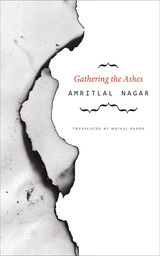 Gathering the Ashes
Amritlal Nagar
Seagull Books, 2016 Most discussions of India’s First War of Independence from British colonial rule in 1857 have centered on the role played by the Mughal emperor, the nawab of Awadh, and other sundry members of mostly urban nobility. What has remained missing from this coverage is how ordinary people across the countryside experienced the rebellion and how they passed their stories down to the following generations. In 1957, eminent Hindi writer Amritlal Nagar set out to correct this, travelling through villages and towns scattered across India’s heartland and painstakingly gathering reminiscences and popular ballads about the revolt—its celebrated and unsung heroes, its survivors and martyrs, and where and how various battles were fought. Aging courtesans, bedridden octogenarians, and nameless singers poured their hearts out to Nagar, and the substantial volume he put together made it clear, even to the lay reader, that nothing can stop the spread of a revolution whose time has come.
Translated from Hindi for the first time by Mrinal Pande, Gathering the Ashes is a poignant look into history, enriched by Pande’s useful afterword and a reminiscence by Nagar’s son.
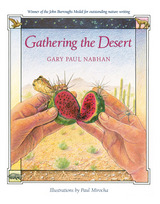 Gathering the Desert
Gary Paul Nabhan; Illustrations by Paul Mirocha
University of Arizona Press, 1985 Winner of the John Burroughs Association’s John Burroughs Medal for natural history writing and a Southwest Book Award from the Border Regional Library Association
To the untrained eye, a desert is a wasteland that defies civilization; yet the desert has been home to native cultures for centuries and offers sustenance in its surprisingly wide range of plant life. Gary Paul Nabhan has combed the desert in search of plants forgotten by all but a handful of American Indians and Mexican Americans. In Gathering the Desert readers will discover that the bounty of the desert is much more than meets the eye—whether found in the luscious fruit of the stately organpipe cactus or in the lowly tepary bean.
Nabhan has chosen a dozen of the more than 425 edible wild species found in the Sonoran Desert to demonstrate just how bountiful the land can be. From the red-hot chiltepines of Mexico to the palms of Palm Springs, each plant exemplifies a symbolic or ecological relationship which people of this region have had with plants through history. Each chapter focuses on a particular plant and is accompanied by an original drawing by artist Paul Mirocha. Word and picture together create a total impression of plants and people as the book traces the turn of seasons in the desert.
 Gathering Together, We Decide: Archives of Dispossession, Resistance, and Memory in Ndé Homelands
Edited by Margo Tamez, Cynthia Bejarano, and Jeffrey P. Shepherd
University of Arizona Press, 2025 In 2007, the Department of Homeland Security began condemnation proceedings on the property of Dr. Eloisa Tamez, a Lipan Apache (Ndé) professor, veteran, and title holder to land in South Texas deeded to her ancestors under the colonial occupation and rule of King Charles III of Spain in 1761, during a time when Indigenous lands were largely taken and exploited by Spanish colonizers. Crown grants of lands to Indigenous peoples afforded them the opportunity to reclaim Indigenous title and control. The federal government wanted Tamez’s land to build a portion of the “border wall” on the U.S.-Mexico border. She refused. In 2008, the Department of Homeland Security sued her, but she countersued based on Aboriginal land rights, Indigenous inherent rights, the land grant from Spain, and human rights. This standoff continued for years, until the U.S. government forced Tamez to forfeit land for the wall.
In response, Dr. Eloisa Tamez and her daughter, Dr. Margo Tamez, organized a gathering of Lipan tribal members, activists, lawyers, and allies to meet in El Calaboz, South Texas. This gathering was a response to the appropriation of the Tamez family land, but it also provided an international platform to dispute the militarization of Indigenous territory throughout the U.S.-Mexico bordered lands. The gathering and years of ensuing resistance and activism produced an archive of scholarly analyses, testimonios, artwork, legal briefs, poetry, and other cultural productions.
This unique collection spotlights powerful voices and perspectives from Ndé leaders, Indigenous elders, settler-allies, Native youth, and others associated with the Tamez family, the Ndé defiance, and the larger Indigenous rights movement to document their resistance; expose, confront, and end racism and militarization; and to foreground Indigenous women–led struggles for justice.
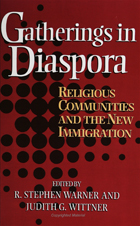 Gatherings In Diaspora: Religious Communities and the New Immigration
edited by Stephen R. Warner and Judith G. Wittner
Temple University Press, 1998 Gatherings in Diaspora brings together the latest chapters in the long-running chronicle of religion and immigration in the American experience. Today, as in the past, people migrating to the United States bring their religions with them, and their religious identities often mean more to them away from home, in their diaspora, than they did before.
This book explores and analyzes the diverse religious communities of post-1965 diasporas: Christians, Hews, Muslims, Hindus, Rastafarians, and practitioners of Vodou, from countries such as China, Guatemala, Haiti, India, Iran, Jamaica, Korea, and Mexico. The contributors explore how, to a greater or lesser extent, immigrants and their offspring adapt their religious institutions to American conditions, often interacting with religious communities already established. The religious institutions they build, adapt, remodel, and adopt become worlds unto themselves, congregations, where new relations are forged within the community -- between men and women, parents and children, recent arrival and those longer settled.
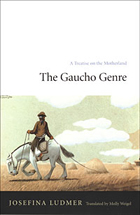 The Gaucho Genre: A Treatise on the Motherland
Josefina Ludmer
Duke University Press, 2002 Hailed when first published in Spanish in 1988 as one of the best contemporary examples of Latin American critical thought, Josefina Ludmer’s El género gauchesco describes the emergence of gaucho poetry—which uses the voice of the cowboy of the Argentine pampas for political purposes—as an urgent encounter of popular and elite tradition, of subaltern and hegemonic discourses. Molly Weigel’s translation captures the original's daringly innovative literary flavor, making available for the first time in English a book that opened a new arena in Latin American cultural history.
By examining the formation of a genre whose origins predated the consolidation of Argentina as a nation-state but that gained significance only after the country's independence, Ludmer elucidates the relationship of literature to the state, as well as the complex positionings of gender within the struggle for independence. She develops a sociological investigation of “outsider” culture through close textual analyses of works by Hidalgo, Ascasubi, Del Campo, Hernandez, Sarmiento, and Borges. This inquiry culminates in the assertion that language, marked as it is by the collisions of high and low culture, constitutes the central issue of Latin American modernization and modernism. Extensive annotation renders this edition of Ludmer's seminal study easily accessible for a North American audience.
The Gaucho Genre’s far-reaching implications will make it valuable reading for a varied audience. While teachers and students of Latin American literature and criticism will find it an important resource, it will also interest those concerned with the processes of nation-building or in the complex intersections of dominant and marginal voices.
Gavin Bolton's Contextual Drama: The Road Less Travelled
Margaret R. Burke
Intellect Books, 2013 Gavin Bolton’s Contextual Drama is the result of more than two decades of study of Bolton’s theory and practice. For teachers and those in the caring professions, it will clarify the power of contextual drama as a beneficial learning medium for children and adults, both within and beyond the classroom. The core of the book is a detailed analysis of nine examples of the contextual drama mode; the first five demonstrate and analyze Bolton’s practice with children and young people and the final four describe his teaching with adults. Each chapter is framed by an introduction that contextualizes Bolton, from his initial beginnings working with visually and aurally-challenged children to his position as reader in drama at Durham University. The final two chapters offer reflection on the nature of this work and, in particular, the significance of Bolton’s contributions to education.
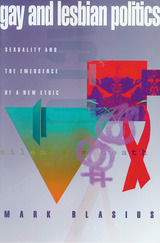 Gay & Lesbian Politics: Sexuality and the Emergence of a New Ethic
Mark Blasius
Temple University Press, 1994 "This important study is both an analysis of and a call to an involved politics. It opens the door to a far-reaching dialogue."
--Martin Duberman, Center for Lesbian and Gay Studies, The City University of New York
An active participant in and theorist of the gay and lesbian movement, Mark Blasius contends that being gay or lesbian is by definition political. By extension, the phenomenon of a movement founded on collective identity is a quintessential part of American politics. The continually rising public consciousness of the needs and interest of gays and lesbians provides Blasius with a vehicle for showing how a particular aspect of human life comes to assume political dimensions. Upon this premise, he analyzes the process of how power is exercised through sexuality and traces the historical conditions that have made possible a gay and lesbian politics
Drawing on works of political philosophy, social science, including Foucault, and gay and lesbian studies, Blasius explores the invention of a gay and lesbian ethos, through which participation, even for apolitical gays and lesbians, goes beyond a shared culture and perspective. It is a way of life more encompassing than either sexual orientation or lifestyle alone. Though he acknowledges and reflects upon the divergent range of gay and lesbian experiences, Blasius provides a framework based on theories of power, sexuality, and ethics that elaborates the significance of the movement as a whole within contemporary society.
"It is in the process of coming out...Blasius argues, that lesbians and gay men create themselves--as new subjects, as the producers of new truth, and as agents of social change. Blasius gives a coherent account that ties together all these processes--from coming out to the emergence of lesbian and gay studies-and goes on to show the 'ethical' contribution that lesbians and gay men make to contemporary American society."
--Harvard Gay & Lesbian Review
"An engaging book that intelligently explores a range of possibilities in human relations."
--George Kateb, Department of Politics, Princeton University
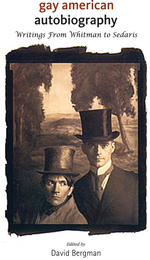 Gay American Autobiography: Writings from Whitman to Sedaris
David Bergman
University of Wisconsin Press, 2009 In the first anthology to survey the full range of gay men’s autobiographical writing from Walt Whitman to the present, Gay American Autobiography draws excerpts from letters, journals, oral histories, memoirs, and autobiographies to provide examples of the best life writing over the last century and a half.
Volume editor David Bergman guides the reader chronologically through selected writings that give voice to every generation of gay writers since the nineteenth century, including a diverse array of American men of African, European, Jewish, Asian, and Latino heritage. Documenting a range of life experiences that encompass tattoo artists and academics, composers and drag queens, hustlers and clerks, it contains accounts of turn-of-the-century transvestites, gay rights activists, men battling AIDS, and soldiers attempting to come out in the army. Each selection provides important insight on the wide spectrum of ways gay men have defined and lived their lives, highlighting how self-awareness changes an author’s experience.
The volume includes an introduction by Bergman and headnotes for each of the nearly forty entries. Bringing many out-of-print and hard-to-find works to new readers, this challenging and comprehensive anthology chronicles American gay history and life struggles over the course of the past 150 years. Finalist, Lambda Book Award for LGBT Anthology, Lambda Literary Foundation
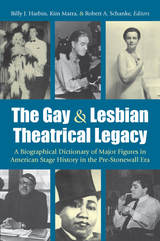 The Gay and Lesbian Theatrical Legacy: A Biographical Dictionary of Major Figures in American Stage History in the Pre-Stonewall Era
Billy J. Harbin, Kim Marra, and Robert A. Schanke, Editors
University of Michigan Press, 2005 “A superb tribute to theatrical pioneers—The Gay and Lesbian Theatrical Legacy is required reading for both theatre scholars and gay/lesbian/bisexual history aficionados. A fascinating journey awaits them all in this highly recommended volume.” —Broadside: Newsletter of the Theatre Library Association The Gay and Lesbian Theatrical Legacy collects in a single volume biographies of more than one hundred notable figures whose careers flourished in the years before the 1969 Stonewall Riots marked the beginning of the gay and lesbian civil rights movement in the United States. The leading lights in American theater have included innumerable individuals whose sexualities have deviated from prevailing norms, but this history has until recently been largely unwritten and unknown. This book contributessignificantly to the recovery of this history, fashioning a much fuller, more nuanced portrait of American theater as it evolved and shedding light on the influence that sexual desire may have had on professional choices, relationships, and artistic achievements. The Gay and Lesbian Theatrical Legacy collects biographies and portraits of influential actors, playwrights, composers, directors, designers, dancers, producers, managers, critics, choreographers, and technicians who made their mark on the American theater. Its broad coverage provides an extended glimpse into lives and careers that intersected and into networks of affiliation that made theatrical history and, by extension, social and cultural history. The late Billy J. Harbin was Professor of Theater, Louisiana State University. Kim Marra is Associate Professor of Theater, University of Iowa. Robert A. Schanke is Professor of Theater Emeritus, Central College, Pella, Iowa.
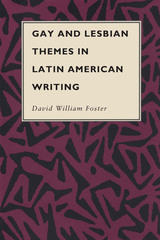 Gay and Lesbian Themes in Latin American Writing
By David William Foster
University of Texas Press, 1991 A taboo subject in many cultures, homosexuality has been traditionally repressed in Latin America, both as a way of life and as a subject for literature. Yet numerous writers have attempted to break the cultural silence surrounding homosexuality, using various strategies to overtly or covertly discuss lesbian and gay themes. In this study, David William Foster examines more than two dozen texts that deal with gay and lesbian topics, drawing from them significant insights into the relationship between homosexuality and society in different Latin American countries and time periods. Foster's study includes works both sympathetic and antagonistic to homosexuality, showing the range of opinion on this topic. The preponderance of his examples come from Argentina, Brazil, and Mexico, countries with historically active gay communities, although he also includes material on other countries. Noteworthy among the authors covered are Reinaldo Arenas, Adolfo Caminha, Isaac Chocrón, José Donoso, Sylvia Molloy, Alejandra Pizarnik, and Luis Zapata.
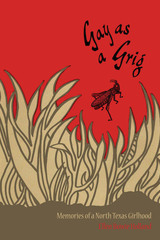 Gay as a Grig: Memories of a North Texas Girlhood
By Ellen Bowie Holland
University of Texas Press, 1963 Ellen Bowie Holland grew up in a house at Weatherford, Texas, that had the "motherly look of a large and gallant hen hovering over too many chicks" and that was inhabited by a "lively, warm-hearted family." This book is her record of the "whole world of little things which enriched young lives" in her small town. Blessed with a discerning and sympathetic eye, she had much happiness to remember and record, and she employs a charming combination of nostalgia and comedy as she brings to life again these bygone days. Her childhood experiences are illuminated by the wisdom of maturity, and the whole is infused with a deft humor, developed through her skilled use of fantasy and through her ability to laugh at the pretensions of the Victorian life she saw. Holland's book also is memorable as a record of her unforgettable parents: "Mother was born on Columbus Day, and she and Columbus had a lot in common. She liked to discover things for herself and nothing pleased her more than to nicely finish off a job that she had been told could not be done" . . . "She wasn't geared for solitary musing. Like a salmon at spawning time she liked to swim upstream against rushing waters and bash into boulders" . . . "Mother's pattern of neatness reached out in all directions" . . . "Mother, sheathed like an armadillo" . . . "Father, silk-hatted, or swallow-tailed, distinguished almost beyond belief" . . . "I never heard him raise his voice or laugh aloud" . . . "Father was not witty but he had an absolutely delightful sense of nonsense. His humor came smoothly upon the scene" . . . Throughout the book the reader shares the author's consciousness of the vast distance between her own childhood and that of the grandchildren to whom the book is dedicated—a distance created by rapid technological change. "From my window I look over an air-conditioned city and I see jets streaking across the sky and occasionally I hear one of them breaking the sound barrier" . . . "When I really want to awe myself I think about the fact that only one generation ago Mother saw friendly or marauding Indians roaming these same acres" . . . "Those of my age have come into a span of years where living conditions of all kinds have changed so abruptly, where obsolescence sets in so rapidly, that there is little in common between our infancy and our present."
 Gay Bar: The Fabulous, True Story of a Daring Woman and Her Boys in the 1950s
Will Fellows
University of Wisconsin Press, 2010 Vivacious, unconventional, candid, and straight, Helen Branson operated a gay bar in Los Angeles in the 1950s—America’s most anti-gay decade. After years of fending off drunken passes as an entertainer in cocktail bars, this divorced grandmother preferred the wit, variety, and fun she found among homosexual men. Enjoying their companionship and deploring their plight, she gave her gay friends a place to socialize. Though at the time California statutes prohibited homosexuals from gathering in bars, Helen’s place was relaxed, suave, and remarkably safe from police raids and other anti-homosexual hazards. In 1957 she published her extraordinary memoir Gay Bar, the first book by a heterosexual to depict the lives of homosexuals with admiration, respect, and love.
In this new edition of Gay Bar, Will Fellows interweaves Branson’s chapters with historical perspective provided through his own insightful commentary and excerpts gleaned from letters and essays appearing in gay publications of the period. Also included is the original introduction to the book by maverick 1950s psychiatrist Blanche Baker. The eclectic selection of voices gives the flavor of American life in that extraordinary age of anxiety, revealing how gay men saw themselves and their circumstances, and how others perceived them. Outstanding Book, selected by the Public Library Association Best Books for High Schools, selected by the American Association of School Libraries
 Gay Cuban Nation
Emilio Bejel
University of Chicago Press, 2001 With Gay Cuban Nation, Emilio Bejel looks at Cuba's markedly homoerotic culture through writings about homosexuality, placing them in the social and political contexts that led up to the Cuban Revolution. By reading against the grain of a wide variety of novels, short stories, autobiographies, newspaper articles, and films, Bejel maps out a fascinating argument about the way in which different attitudes toward power and nationalism struggle for an authoritative stance on homosexual issues. Through close readings of writers such as José Martí, Alfonso Hernández-Catá, Carlos Montenegro, José Lezama Lima, Leonardo Padura Fuentes, and Reinaldo Arenas, whose heartbreaking autobiography, Before Night Falls, has enjoyed renewed popularity, Gay Cuban Nation shows that the category of homosexuality is always lurking, ghostlike, in the shadows of nationalist discourse. The book stakes out Cuba's sexual battlefield, and will challenge the homophobia of both Castro's revolutionaries and Cuban exiles in the States.
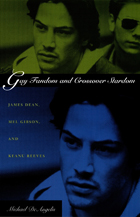 Gay Fandom and Crossover Stardom: James Dean, Mel Gibson, and Keanu Reeves
Michael DeAngelis
Duke University Press, 2001 Why and how does the appeal of certain male Hollywood stars cross over from straight to gay audiences? Do stars lose their cachet with straight audiences when they cross over? In Gay Fandom and Crossover Stardom Michael DeAngelis responds to these questions with a provocative analysis of three famous actors—James Dean, Mel Gibson, and Keanu Reeves. In the process, he traces a fifty-year history of audience reception that moves gay male fandom far beyond the realm of “camp” to places where culturally unauthorized fantasies are nurtured, developed, and shared.
DeAngelis examines a variety of cultural documents, including studio publicity and promotional campaigns, star biographies, scandal magazines, and film reviews, as well as gay political and fan literature that ranges from the closeted pages of One and Mattachine Review in the 1950s to the very “out” dish columns, listserv postings, and on-line star fantasy narratives of the past decade. At the heart of this close historical study are treatments of particular film narratives, including East of Eden, Rebel Without a Cause, The Road Warrior, Lethal Weapon, My Own Private Idaho, and Speed. Using theories of fantasy and melodrama, Gay Fandom and Crossover Stardom demonstrates how studios, agents, and even stars themselves often actively facilitate an audience’s strategic blurring of the already tenuous distinction between the heterosexual mainstream and the gay margins of American popular culture.
In addition to fans of James Dean, Mel Gibson, and Keanu Reeves, those interested in film history, cultural studies, popular culture, queer theory, gender studies, sociology, psychoanalytic theory, melodrama, fantasy, and fandom will enjoy this book.
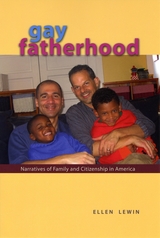 Gay Fatherhood: Narratives of Family and Citizenship in America
Ellen Lewin
University of Chicago Press, 2009 Men are often thought to have less interest in parenting than women, and gay men are generally assumed to prefer pleasure over responsibility. The toxic combination of these two stereotypical views has led to a lack of serious attention being paid to the experiences of gay fathers. But the truth is that more and more gay men are setting out to become parents and succeeding—and Gay Fatherhood aims to tell their stories. Ellen Lewin takes as her focus people who undertake the difficult process of becoming fathers as gay men, rather than having become fathers while married to women. These men face unique challenges in their quest for fatherhood, negotiating specific bureaucratic and financial conditions as they pursue adoption or surrogacy and juggling questions about their future child’s race, age, sex, and health. Gay Fatherhood chronicles the lives of these men, exploring how they cope with political attacks from both the "family values" right and the "radical queer" left—while also shedding light on the evolving meanings of family in twenty-first-century America.
 Gay, Inc.: The Nonprofitization of Queer Politics
Myrl Beam
University of Minnesota Press, 2018 A bold and provocative look at how the nonprofit sphere’s expansion has helped—and hindered—the LGBT cause
What if the very structure on which social movements rely, the nonprofit system, is reinforcing the inequalities activists seek to eliminate? That is the question at the heart of this bold reassessment of the system’s massive expansion since the mid-1960s. Focusing on the LGBT movement, Myrl Beam argues that the conservative turn in queer movement politics, as exemplified by the shift toward marriage and legal equality, is due mostly to the movement’s embrace of the nonprofit structure.
Based on oral histories as well as archival research, and drawing on the author’s own extensive activist work, Gay, Inc. presents four compelling case studies. Beam looks at how people at LGBT nonprofits in Minneapolis and Chicago grapple with the contradictions between radical queer social movements and their institutionalized iterations. Through interview subjects’ incisive, funny, and heartbreaking commentaries, Beam exposes a complex world of committed people doing the best they can to effect change, and the flawed structures in which they participate, rail against, ignore, and make do. Providing a critical look at a social formation whose sanctified place in the national imagination has for too long gone unquestioned, Gay, Inc. marks a significant contribution to scholarship on sexuality, neoliberalism, and social movements.
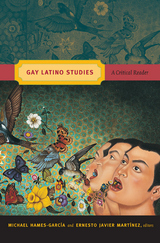 Gay Latino Studies: A Critical Reader
Michael Hames-García and Ernesto Javier Martínez, eds.
Duke University Press, 2011 The authors of the essays in this unique collection explore the lives and cultural contributions of gay Latino men in the United States, while also analyzing the political and theoretical stakes of gay Latino studies. In new essays and influential previously published pieces, Latino scholars based in American studies, ethnic studies, history, performance studies, and sociology consider gay Latino scholarly and cultural work in relation to mainstream gay, lesbian, and queer academic discourses and the broader field of Chicano and Latino studies. They also critique cultural explanations of gay Latino sexual identity and behavior, examine artistic representations of queer Latinidad, and celebrate the place of dance in gay Latino culture. Designed to stimulate dialogue, the collection pairs each essay with a critical response by a prominent Latino/a or Chicana/o scholar. Terms such as gay, identity, queer, and visibility are contested throughout the volume; the significance of these debates is often brought to the fore in the commentaries. The essays in Gay Latino Studies complement and overlap with the groundbreaking work of lesbians of color and critical race theorists, as well as queer theorists and gay and lesbian studies scholars. Taken together, they offer much-needed insight into the lives and perspectives of gay, bisexual, and queer Latinos, and they renew attention to the politics of identity and coalition. Contributors. Tomás Almaguer, Luz Calvo, Lionel Cantú,, Daniel Contreras, Catriona Rueda Esquibel, Ramón García, Ramón A. Gutiérrez, Michael Hames-García, Lawrence La Fountain-Stokes, María Lugones, Ernesto J. Martínez, Paula M. L. Moya, José Esteban Muñoz, Frances Negrón-Muntaner, Ricardo L. Ortiz, Daniel Enrique Pérez, Ramón H. Rivera-Servera, Richard T. Rodríguez, David Román, Horacio N. Roque Ramírez, Antonio Viego
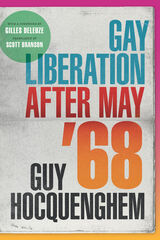 Gay Liberation after May '68
Guy Hocquenghem
Duke University Press, 2022 In Gay Liberation after May ’68, first published in France in 1974 and appearing here in English for the first time, Guy Hocquenghem details the rise of the militant gay liberation movement alongside the women’s movement and other revolutionary organizing. Writing after the apparent failure and eventual selling out of the revolutionary dream of May 1968, Hocquenghem situates his theories of homosexual desire in the realm of revolutionary practice, arguing that revolutionary movements must be rethought through ideas of desire and sexuality that undo stable gender and sexual identities. Throughout, he persists in a radical vision of the world framed through a queerness that can dismantle the oppressions of capitalism and empire, the family, institutions, and, ultimately, civilization. The articles, communiques, and manifestos that compose the book give an archival glimpse at the issues queer revolutionaries faced while also speaking to today’s radical queers as they look to transform their world.
 Gay Lives: Homosexual Autobiography from John Addington Symonds to Paul Monette
Paul Robinson
University of Chicago Press, 1999 In his autobiography, John Addington Symonds relates a glorious night of passion, in which he and his lover "lay covered from the cold in bed, tasting the honey of softly spoken words and the blossoms of lips pressed on lips." Christopher Isherwood's first autobiography, on the other hand, was far less direct; he wrote a second autobiography in part because the first was "not truly autobiographical" in that "the author conceals important facts about himself." These contradictions, evasions, and explicit sexual details of the life stories of fourteen men form Gay Lives, a revealing account of homosexual autobiography.
Paul Robinson reads the memoirs of French, British, and American gay authors—André Gide, Quentin Crisp, and Martin Duberman, among others—through the prism of sexual identity, asking fascinating questions about homosexuality and its relation to literary form. How did these authors discover their sexual identity? Did they embrace it or reject it? How did they express often conflicted desires in their words, which ranged from defiant and brutally frank to ambiguous and abstract? Robinson considers the choices each made—as a man and an author—to accommodate himself to society's homophobia or live in protest against his oppression.
Despite the threads that connect these stories, Gay Lives refutes the notion that there is a typical homosexual "career" by showing that gay men have led wildly dissimilar lives—from the exuberant to the miserable—and that they have found no less dissimilar meanings in those lives.
Gay Men at the Movies: Cinema, Memory and the History of a Gay Male Community
Scott McKinnon
Intellect Books, 2016 Cinema has long played a major role in the formation of community among marginalized groups, and this book details that process for gay men in Sydney, Australia from the 1950s to the present. Scott McKinnon builds the book from a variety of sources, including film reviews, media reports, personal memoirs, oral histories, and a striking range of films, all deployed to answer the question of understanding cinema-going as a moment of connection to community and identity—how the experience of seeing these films and being part of an audience helped to build a community among the gay men of Sydney in the period.
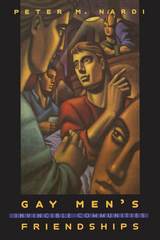 Gay Men's Friendships: Invincible Communities
Peter M. Nardi
University of Chicago Press, 1999 Based on surveys and interviews of two hundred gay men, Peter Nardi's new study presents the first book-length examination of contemporary urban gay men's friendships. Expertly weaving historical and sociological research on friendship with firsthand information, Nardi argues that friendship is the central organizing element of gay men's lives. Through friendship, gay identities and communities are created, transformed, maintained, and reproduced.
Nardi explores the meaning of friends to some gay men, how friends often become a surrogate family, how sexual behavior and attraction affects these friendships, and how, for many, friends mean more and last longer than romantic relationships. While looking at the psychological joys and sorrows of friendship, he also considers the cultural constraints limiting gay men in contemporary urban America—especially those that deal with dominant images of masculinity and heterosexuality—and how they relate to friendship.
By listening to gay men talk about their interactions, Nardi offers a rare glimpse into the mechanisms of gay life. We learn how gay men meet their friends, what they typically do and talk about, and how these strong relationships contain the roots of larger cultural forces such as social movements and gay identities and neighborhoods. Nardi also points out the political and social consequences when friendships fail to provide support against oppression.
An intimate and informative look at gay life in urban America, Gay Men's Friendships ultimately shows how these relationships challenge the gender order of our society by questioning how masculinity is constructed and by offering a model for a more creative blending of gay and heterosexual masculinity.
The Gay Place
By Billy Lee Brammer
University of Texas Press, 1995 Set in Texas, The Gay Place consists of three interlocking novels, each with a different protagonist—a member of the state legislature, the state's junior senator, and the governor's press secretary. The governor himself, Arthur Fenstemaker, a master politician, infinitely canny and seductive, remains the dominant figure throughout. Billy Lee Brammer—who served on Lyndon Johnson's staff—gives us here "the excitement of a political carnival: the sideshows, the freaks, and the ghoulish comedy atmosphere" (Saturday Review). Originally published in 1961, The Gay Place is at once a cult classic and a major American novel.
 Gay Print Culture: A Transnational History of North America
Juan Carlos Mezo González
Duke University Press, 2026 In Gay Print Culture, Juan Carlos Mezo González investigates the relationship between transnational gay liberation politics, periodicals, and images in Mexico, the United States, and Canada from the early 1970s through the mid-1990s. Mezo González examines the production, content, circulation, and reception of leading gay periodicals published in these countries, including community-based gay liberation publications and commercially oriented gay lifestyle and erotic magazines. He demonstrates how they aimed to visualize the political goals of gay liberation, particularly those concerning the liberation and celebration of homoerotic desires. Mezo González contends that visualizing these goals allowed activists, editors, publishers, and artists to foster the formation of gay communities and identities while advancing gay liberation movements at the local, national, and international levels. In so doing, he furthers understandings of the transnational nature of gay periodicals, the relationship between gay liberation politics and visual culture, and the existing tensions between the liberation of some and the oppression of others across the American continent.
Gay Priori: A Queer Critical Legal Studies Approach to Law Reform
Libby Adler
Duke University Press, 2018 Libby Adler offers a comprehensive critique of the mainstream LGBT legal agenda in the United States, showing how LGBT equal rights discourse drives legal advocates toward a narrow array of reform objectives that do little to help the lives of the most marginalized members of the LGBT community.
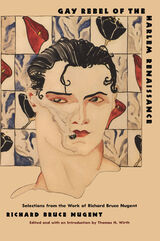 Gay Rebel of the Harlem Renaissance: Selections from the Work of Richard Bruce Nugent
Richard Bruce Nugent
Duke University Press, 2002 Richard Bruce Nugent (1906–1987) was a writer, painter, illustrator, and popular bohemian personality who lived at the center of the Harlem Renaissance. Protégé of Alain Locke, roommate of Wallace Thurman, and friend of Langston Hughes and Zora Neale Hurston, the precocious Nugent stood for many years as the only African-American writer willing to clearly pronounce his homosexuality in print. His contribution to the landmark publication FIRE!!, “Smoke, Lilies and Jade,” was unprecedented in its celebration of same-sex desire. A resident of the notorious “Niggeratti Manor,” Nugent also appeared on Broadway in Porgy (the 1927 play) and Run, Little Chillun (1933)
Thomas H. Wirth, a close friend of Nugent’s during the last years of the artist’s life, has assembled a selection of Nugent’s most important writings, paintings, and drawings—works mostly unpublished or scattered in rare and obscure publications and collected here for the first time. Wirth has written an introduction providing biographical information about Nugent’s life and situating his art in relation to the visual and literary currents which influenced him. A foreword by Henry Louis Gates Jr. emphasizes the importance of Nugent for African American history and culture.
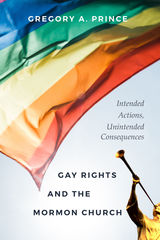 Gay Rights and the Mormon Church: Intended Actions, Unintended Consequences
Gregory A. Prince
University of Utah Press, 2019 The Mormon Church entered the public square on LGBT issues by joining forces with traditional-marriage proponents in Hawaii in 1993. Since then, the church has been a significant player in the ongoing saga of LGBT rights within the United States and at times has carried decisive political clout. Gregory Prince draws from over 50,000 pages of public records, private documents, and interview transcripts to capture the past half-century of the Mormon Church’s attitudes on homosexuality. Initially that principally involved only its own members, but with its entry into the Hawaiian political arena, the church signaled an intent to shape the outcome of the marriage equality battle. That involvement reached a peak in 2008 during California’s fight over Proposition 8, which many came to call the “Mormon Proposition.” In 2015, when the Supreme Court made marriage equality the law of the land, the Mormon Church turned its attention inward, declaring same-sex couples “apostates” and denying their children access to key Mormon rites of passage, including the blessing (christening) of infants and the baptism of children. Prince's interview with KUER: https://radiowest.kuer.org/post/gay-rights-and-mormon-church Prince's Q-Talk with Equality Utah: https://www.youtube.com/watch?v=vcnVagLY-lM&feature=youtu.be Prince's interview with the Press: https://conta.cc/2HHmeTm Princes's event with Benchmark Books: https://youtu.be/Daz-TFldZDA
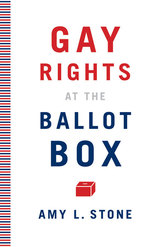 Gay Rights at the Ballot Box
Amy L. Stone
University of Minnesota Press, 2012 The passage of the anti-gay marriage Proposition 8 in California in 2008 stunned gay rights activists across the country. Although facing a well-funded campaign in support of the ballot measure, LGBT activists had good reasons for optimism, including the size and strength of their campaign. Since 1974, the LGBT movement has fought 146 anti-gay ballot initiatives sponsored by the religious right and has developed innovative strategies to oppose these measures. In Gay Rights at the Ballot Box, Amy L. Stone examines how the tactics of LGBT activists have evolved and unravels the complex relationship between ballot measure campaigns and the broader goals of the LGBT movement. The first comprehensive history of anti-gay ballot measures, both those merely attempted and those successfully put before voters, this book draws on archival research and interviews with more than one hundred LGBT activists to provide a detailed account of the campaigns to stop such ballot measures from passing into law. As Stone shows through in-depth case studies, although LGBT activists lost the vast majority of these fights, they also won significant statewide victories in Oregon in 1992 and Arizona in 2006, and local successes, including ones in Ypsilanti, Michigan, in 1998 and 2002. Stone analyzes how LGBT activists constantly refined their campaign tactics in response to both victories and defeats. She also stresses that such campaigns have played both a complementary and contradictory role within the LGBT movement. Specific anti-ballot campaigns and the broader movement do often strengthen each other. However, ballot measure campaigns sometimes distract activists from the movement’s more general goals, and activists at the movement level can pressure local campaigns to take on more than they can handle. With gay rights coming under increasing assault from the religious right, this book is a vital resource for LGBT activists and others working to block their efforts.
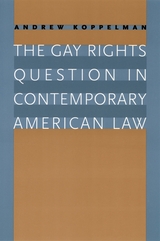 The Gay Rights Question in Contemporary American Law
Andrew Koppelman
University of Chicago Press, 2002 The gay rights question is whether the second-class legal status of gay people should be changed. In this book Andrew Koppelman shows the powerful legal and moral case for gay equality, but argues that courts cannot and should not impose it.
The Gay Rights Question in Contemporary American Law offers an unusually nuanced analysis of the most pressing gay rights issues. Does antigay discrimination violate the Constitution? Is there any sound moral objection to homosexual conduct? Are such objections the moral and constitutional equivalent of racism? Must state laws recognizing same-sex unions be given effect in other states? Should courts take account of popular resistance to gay equality? Koppelman sheds new light on all these questions. Sure to upset purists on either side of the debate, Koppelman's book criticizes the legal arguments advanced both for and against gay rights. Just as important, it places these arguments in broader moral and social contexts, offering original, pragmatic, and workable legal solutions.
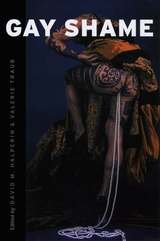 Gay Shame
Edited by David M. Halperin and Valerie Traub
University of Chicago Press, 2009 Ever since the 1969 Stonewall Riots, “gay pride” has been the rallying cry of the gay rights movement and the political force behind the emergence of the field of lesbian and gay studies. But has something been lost, forgotten, or buried beneath the drive to transform homosexuality from a perversion to a proud social identity? Have the political requirements of gay pride repressed discussion of the more uncomfortable or undignified aspects of homosexuality?
Gay Shame seeks to lift this unofficial ban on the investigation of homosexuality and shame by presenting critical work from the most vibrant frontier in contemporary queer studies. An esteemed list of contributors tackles a range of issues—questions of emotion, disreputable sexual histories, dissident gender identities, and embarrassing figures and moments in gay history—as they explore the possibility of reclaiming shame as a new, even productive, way to examine lesbian and gay culture.
Accompanied by a DVD collection of films, performances, and archival imagery, Gay Shame constitutes nothing less than a major redefinition and revitalization of the field.
 Gay TV and Straight America
Becker, Ron
Rutgers University Press, 2006 After decades of silence on the subject of homosexuality, television in the 1990s saw a striking increase in programming that incorporated and, in many cases, centered on gay material. In shows including Friends, Seinfeld, Party of Five, Homicide, Suddenly Susan, The Commish, Ellen, Will & Grace, and others, gay characters were introduced, references to homosexuality became commonplace, and issues of gay and lesbian relationships were explored, often in explicit detail. In Gay TV and Straight America, Ron Becker draws on a wide range of political and cultural indicators to explain this sudden upsurge of gay material on prime-time network television. Bringing together analysis of relevant Supreme Court rulings, media coverage of gay rights battles, debates about multiculturalism, concerns over political correctness, and much more, Becker's assessment helps us understand how and why televised gayness was constructed by a specific culture of tastemakers during the decade. On one hand the evidence points to network business strategies that embraced gay material as a valuable tool for targeting a quality audience of well-educated, upscale adults looking for something "edgy" to watch. But, Becker also argues that the increase of gay material in the public eye creates growing mainstream anxiety in reaction to the seemingly civil public conversation about equal rights. In today's cultural climate where controversies rage over issues of gay marriage yet millions of viewers tune in weekly to programs like Queer Eye for the Straight Guy, this book offers valuable insight to the complex condition of America's sexual politics.
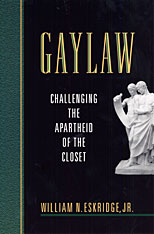 Gaylaw: Challenging the Apartheid of the Closet
William N. Eskridge Jr.
Harvard University Press, 1999 This book provides a comprehensive analysis of the legal issues concerning gender and sexual nonconformity in the United States. Part One, which covers the years from the post-Civil War period to the 1980s, is a history of state efforts to discipline and punish the behavior of homosexuals and other people considered to be deviant. During this period such people could get by only at the cost of suppressing their most basic feelings and emotions. Part Two addresses contemporary issues. Although it is no longer illegal to be openly gay in America, homosexuals still suffer from state discrimination in the military and in other realms, and private discrimination and violence against gays is prevalent. William Eskridge presents a rigorously argued case for the "sexualization" of the First Amendment, showing why, for example, same-sex ceremonies and intimacy should be considered "expressive conduct" deserving the protection of the courts. The author draws on legal reasoning, sociological studies, and history to develop an effective response to the arguments made in defense of the military ban. The concluding part of the book locates the author's legal arguments within the larger currents of liberal theory and integrates them into a general stance toward freedom, gender equality, and religious pluralism.
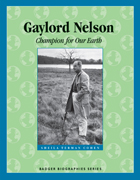 Gaylord Nelson: Champion for Our Earth
Sheila Terman Cohen
Wisconsin Historical Society Press, 2010 Earth Day creator Gaylord Nelson comes to vivid life in this addition to the Badger Biographies series for young readers. Accessibly written and richly illustrated with historic images, Gaylord Nelson: Champion for Our Earth includes a glossary of terms, sidebars on World War II, DDT, and several facets of the environmental movement, plus activities and discussion questions. Born in Clear Lake, Wisconsin, in 1916, Gaylord grew up as immersed in his parents' political work and community service as he was in playing practical jokes and exploring the natural world surrounding his home town. Along the way he encountered experiences that would shape him in fundamental ways: as a man who stood up for what he believed in the face of opposition and yet who also understood how to treat his opponents with respect. Both traits would serve him well as he rose from law student to state senator to Wisconsin governor and finally to three terms as a United States Senator. Nelson fought to treat all races equally and to condemn McCarthy-era paranoia, but his greatest contribution was to sound the alarm about another battle: the fight to save the natural world and the earth itself. It was his idea to use teach-ins to let people know that the environment needed their help. Thanks to him, more natural resources were conserved and new laws demanded clean air and water. Now, every year on April 22, people all over the world plant trees and pick up litter to celebrate Earth Day. The Earth and its inhabitants aren't safe yet, but Gaylord Nelson demonstrated that even one person can help to save the world.
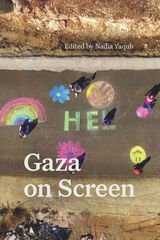 Gaza on Screen
Nadia Yaqub, editor
Duke University Press, 2023 Gaza’s long association with resistance and humanitarian need has generated a complex and ever shifting range of visual material, comprising not just news reports and documentaries, but also essay, experimental, and fiction films, militant videos, and solidarity images. Contributors to Gaza on Screen, who include scholars and Gazan filmmakers, explore the practice, production, and impact of film and videos from and about the Gaza Strip. Conceptualizing screens—both large and small—as tools for mediation that are laden with power, the volume explores Gazan film and video in relation to humanitarianism and human rights, care, community, environment, mobility and confinement, and decolonization. The volume includes visual material ranging from solidarity broadcasts on Lebanese television, mid-twentieth-century British Pathé newsreels, and fiction films to breaking news, visuals of contemporary militant resistance, documentaries, and found footage films, arguing for a visual ecosystem in which differing types of film and video affect and inform each other. Throughout, Gaza on Screen demonstrates that screens shape and sustain relationships between Gaza and the world, and help to sustain the possibility of a different future.
Contributors. Nayrouz Abu Hatoum, Shahd Abusalama, Samirah Alkassim, Basma Alsharif, Hadeel Assali, Azza El-Hassan, Hatim El-Hibri, Mohamed Jabaly, Ahmed Mansour, Arab Nasser, Tarzan Nasser, Kamran Rastegar, Viviane Saglier, Abdelsalam Shehada, Yaron Shemer, Rebecca L. Stein, Helga Tawil-Souri, Shaira Vadasaria, Nadia Yaqub
 Gaze and Voice as Love Objects: SIC 1
Renata Salecl and Slavoj Žižek, eds.
Duke University Press, 1996 The gaze entices, inspects, fascinates. The voice hypnotizes, seduces, disarms. Are gaze and voice part of the relationship we call love . . . or hate? If so, what part? How do they function? This provocative book examines love as the mediating entity in the essential antagonism between the sexes, and gaze and voice as love's medium. The contributors proceed from the Lacanian premise that "there is no sexual relationship," that the sexes are in no way complementary and that love—figured in the gaze and the voice —embodies the promise and impossibility of any relation between them. The first detailed Lacanian elaboration of this topic, Gaze and Voice as Love Objects examines the status of gaze, voice, and love in philosophy from Plato to Kant, in ideology from early Christianity to contemporary cynicism, in music from Hildegard of Bingen to Richard Wagner, in literature from Edith Wharton's Age of Innocence to Kazuo Ishiguro's The Remains of the Day, and in cinema from Michael Powell's Peeping Tom to Kieslowski's A Short Film on Love. Throughout, the contributors seek to show that the conflict between the sexes is the site of a larger battle over the destiny of modernity. With insights into the underlying target of racist and sexist violence, this book offers surprising revelations into the nature of an ancient enigma—love. Contributors. Elisabeth Bronfen, Mladen Dolar, Fredric Jameson, Renata Salecl, Slavoj Žižek, Alenka Zupancic
A Gaze Hound That Hunteth By the Eye: Poems
Penelope V. Pelizzon
University of Pittsburgh Press, 2024 Written over a decade while the author lived on four continents, A Gaze Hound That Hunteth by the Eye maps the cultural legacies we cherish against those we reject. Playful and wrenching by turns, with lines inflected by the spoken music of their Arabic, Oshiwambo, Xhosa, and Italian contexts, these profound poems explore a life where displacement is the norm. From choosing not to have children to wrestling with a left-hand stick shift in Johannesburg traffic to braising a camel loin for friends in Damascus, V. Penelope Pelizzon’s poems transport us into unexpected depths of feeling with language that is scintillant, luxurious, and wise.
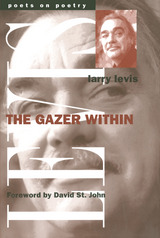 The Gazer Within
Larry Levis
University of Michigan Press, 2001 The Gazer Within collects the prose of one of America's favorite poets. Refreshingly candid, laugh-out-loud funny, and, at the same time, intimate, the pieces trace Larry Levis's early years growing up on his father's farm, his decision at sixteen to become a poet, and his undergraduate experience in the days of the Vietnam War. In addition to memoir, there are critical reviews, including his seminal essay on the poet Philip Levine, and reviews of poets as diverse as W. D. Snodgrass and Zbigniew Herbert.
David St. John's foreword speaks eloquently of Levis's enduring legacy: "Of the poets of his generation, Larry Levis spoke most powerfully of what it means to be a poet at this historical moment. With the same majesty he brought to his poetry, Larry Levis engaged his readers with the most subtle and disturbing questions of the self to be found in the prose--essays, reviews or interviews--of any contemporary American poet. Broadly international in his scope and deeply personal in his reflections, Levis addressed poetic concerns that are both immediate and timeless. For many of us who struggle with these issues, Larry Levis's prose on poetry stands as some of the most capacious to be found since Randell Jarrell's."
The late Larry Levis was the author of six volumes of poetry. He was Director of the Creative Writing Program, University of Utah; Professor of English, Virginia Commonwealth University; and also taught at the Iowa Writers Workshop.
 The Gazer's Spirit: Poems Speaking to Silent Works of Art
John Hollander
University of Chicago Press, 1995 This magnificent book is a gallery of words and images that celebrates the sister arts of poetry and painting. John Hollander, the eminent poet and critic, has selected more than fifty works of art—paintings, prints, drawings, photographs, and sculptures from antiquity to the present—and matched them to poems that address the same images in their verses. The result is an illuminating and ingeniously organized chronicle of words and images in conversation, as well as a powerful introduction to how, across Western culture, great writers have been inspired by pictures.
The Gazer's Spirit focuses on leading examples of ecphrastic poetry, or poems that directly confront particular works of art. Hollander, who is one of the most distinguished contemporary practitioners of the ecphrastic tradition, has crafted a survey of enormous range, taste, and depth, from the Renaissance to the twentieth century. The heart of the book is its gallery of poems and images set side by side.
There are poems whose presence in this book is all but inevitable, such as Auden's "Musee des Beaux Arts" paired with Breugel the Elder's Landscape with the Fall of Icarus, and delightful surprises, such as Edith Wharton's sonnet that casts fresh light on Leonardo's Mona Lisa. Here are Robert Browning and Michelangelo; Walt Whitman and George Inness; and Randall Jarrell and Albrecht Dürer writing and drawing about The Knight, Death and the Devil.
Among the poets are many visually sophisticated writers such as James Merrill, Richard Howard, Marianne Moore, and Richard Wilbur; the visual objects in the book are both celebrated and obscure, as various as a Greek sculplture, a medieval tapestry, a famous Renoir, or a fountain by an anonymous architect. In some cases, obvious affinities, such as a poem by Vicki Hearne on a white horse by Gauguin, produce unexpected poetic results.
A Gazetteer of Buildings in Muslim Palestine
Andrew Petersen
Council for British Research in the Levant, 2001 The aim of the survey on which this book is based was to make a record of all buildings constructed in Palestine during the medieval and Ottoman periods. The survey area covers the modern state of Israel excluding West Jerusalem and Ramla (which are covered in separate publications). The West Bank and Gaza will be the subject of Volume II.
Library of Congress subject headings for this publication:
Architecture, Islamic -- Palestine -- Guidebooks.
Architecture, Ottoman -- Palestine -- Guidebooks.
Architecture, Medieval -- Palestine -- Guidebooks.
Historic buildings -- Palestine -- Guidebooks.
| |



